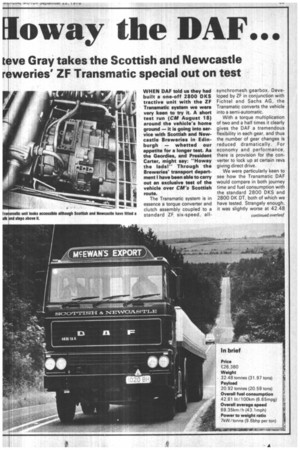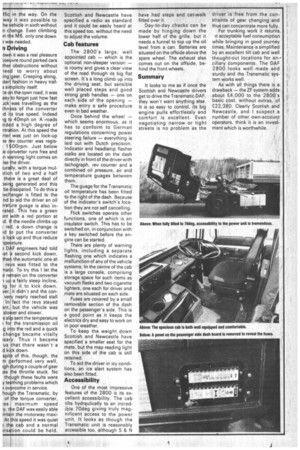oway the DAF...
Page 41

Page 42

Page 43

If you've noticed an error in this article please click here to report it so we can fix it.
ye Gray takes the Scottish and Newcastle r weries' ZF Transmatic special out on test
WHEN DAF told us they had built a one-off 2800 DKS tractive unit with the ZF Transmatic system we were very keen to try it. A short test run (CM August 18) around the vehicle's home ground — it is going into service with Scottish and Newcastle Breweries in Edinburgh — whetted our appetite for a longer test. As the Geordies, and President Carter, might say: "Howay the lads!" Through the Breweries' transport department I have been able to carry out an exclusive test of the vehicle over CM's Scottish route.
The Transmatic system is in essence a torque converter and clutch assembly coupled to a standard ZF. six-speed, all
synchromesh gearbox. Developed by ZF in conjunction with Fichtel and Sachs AG, the Transmatic converts the vehicle into a semi-automatic.
With a torque multiplication of two and a half times it clearly gives the DAF a tremendous flexibility in each gear, and thus the number of gear changes is reduced dramatically. For economy and performance, there is provision for the converter to lock up at certain revs giving direct drive.
We were particularly keen to see how the Transmatic DAF would compare in both journey time and fuel consumption with the standard 2800 DKS and 2800 DK DT, both of which we have tested. Strangely enough, it was slightly worse at 42.48 lit/100km (6165mpg) overall than the smaller engined DKDT (the DKS has an output of '307bhp against the DKDT's 248bhp). However, it was substantially down on the conventionally gearboxed DKS which achieved 38.7 litre/100km / (7.3mpg) overall.
In its defence, though, it must be said the Transmatic was 24 minutes quicker overall than the DKDT and 18 minutes faster than its manual stablemate.
The test was somewhat marred as a large quantity of fuel was siphoned out during our overnight stop at Pathhead, thus effectively ruining the fuel consumption figure between Gretna and Pathhead. Nevertheless it would be fair, I believe, to assume the DAF Transmatic would have brought in a similar figure for this section as the DKDT, which returned 42.8 lit/100km (6.6mpg).
Fuel consumption
The reason for this assumption is that the two vehicles achieved very similar results, section by section. For example, the DKDT returned 40.94 lit/ 100 (6.9 mpg) from Hemel Hempstead to Forton compared to the DKS's at 40.76 lit/ 100km (6.93mpg). On the hilly A68 section from Rochester through to Neville's Cross they were again close, with the Transrnatic producing 64.94 lit/100km (4.35mpg) against 64.2 lit/100km (4.4mpg).
In view of this, our overall figure, calculated from the fuel
actually used against the E .tions of the route unaffect may perhaps be a little on poor side. I would think aroi the DKDT's overall would b more likely result.
Fuel consumption apart, OAF was a pleasure to driv€ will pull away in third gear w out fuss and an upward chai isn't necessary for quite a wt The ZF box has the le sprung toward the centre third and fourth and this is r convenient to use. Driving Transmatic DAF needs so thought at first to get used to system. Basically the clutct depressed, a gear selected usually third — and the cit. released.
Nothing then happens u the throttle is depressed. 0 on the move those gear chars that are needed are accc Wished by dipping the dui moving the lever and quic releasing the clutch: There's need to change up in stac and I found it was quite poss to change from third to si without effort.
The higher gears are in situated further away from driver than the lower ones, to the translation from lefi right-hand drive. To prey damage during changes, th is a lock-out device wh isolates the throttle.
I found the DAF particul. good on 'A.-roads, for wl coming up to a roundab usually only one down chan from sixth to fifth was enoug get round, provided there s
ffic in the way. On the way it was possible to he yehicle in sixth without n change. Even climbing in the M6, only one down 3w s needed.
n Driving
own it was a real pleasure toeuvre round parked cars ther obstructions without leed to worry about ing gear. Creeping along, ;tar. fashion in heavy traf;simplicity itself.
on the open road, it was asy to forget just how fast Jck was travelling as the thness of the converter !d i.s true speed. Indeed ig to 40mph on 'A'-roads nded a high degree of ntration. At this speed the rter was just on lock-up le rev counter was regis1500rpm. Just below le converter runs free and n Warning light comes on ise the driver.
iuraly, with a torque mulition of two and a half there is a great deal of )eing generated and this be dissipated. To do this a ;xcl-anger is fitted to the nd o aid the driver an oil rat=ire guage is also inrated. This has a green !nt with a red portion at id. If the needle climbs up red, a down change is !d to put the converter o lock up and thus reduce
ature.
DAF engineers had told at a second kick down, than the automatic one at revs was fitted to the 'net c. To try this I let the e remain on the converter up a fairly steep incline, lg for it to kick down. ver, it didn't and the convery nearly reached stall In fact the revs stayed 3nt, but the vehicle was slower and slower.
s slip sent the temperature fo. the transmission oil g into the red and a quick change became vitally isary. Thus it became us that there wasn't a d kick down.
spite of this, though, the rri lerformed very well, igh during a couple of gear les the throttle stuck. No thcugh these faults were y teething problems which ?overcome in service.
hough the Transmatic, by of the torque converter, :es maximum speed y, the DAF was easily able inta n the motorway maxiAt this speed it was quiet the cab and a normal 3rsation could be held. Scottish and Newcastle have specified a radio as standard and it could be easily heard at this speed too, without the need to adjust the volume.
Cab features
The 2800's large, well appointed cab — which is the optional non-sleeper version — is roomy and gives a clear view of the road through its big flat screen. It's a long climb up into the driving seat, but sensible well placed steps and good strong grab handles — one on each side of the opening — make entry a safe procedure even in bad weather, Once behind the wheel — which seems enormous, as it has to conform to German regulations concerning power steering failure — everything is laid out with Dutch precision.
Indicator and headlamp flasher stalks are located on the dash directly in front of the driver with tachograph, rev counter and a combined oil pressure, air and temperature guages between them.
The guage for the Transmatic oil temperature has been fitted to the right of the dash. Because of the indicator's switch's location they are not self cancelling.
Flick switches operate other functions, one of which is an insulator switch. This has to be switched on, in conjunction with a key switched before the engine can be started.
There are plenty of warning lights, including a separate flashing one which indicates a malfunction of any of the vehicle systems. In the centre of the cab is a large console, comprising storage space for such items as vacuum flasks and two cigarette lighters, one each for driver and mate are situated on each side.
Fuses are covered by a small removable section of the dash on the passenger's side. This is a good point as it keeps the electrics dry and easy to work on in poor weather.
To keep the weight down Scottish and Newcastle have specified a smaller seat for the mate, but the map reading light on this side of the cab is still retained.
To aid the driver in icy conditions, an ice alert system has also been fitted.
Accessibility
One of the most impressive features of the 2800 is its excellent accessibility. The cab tilts hydraulically to an incredible 70deg giving truly magnificent access to the power unit. It looks as though the Transmatic unit is reasonably accessible too, although S & N have had steps and cat-walk fitted over it.
Day-to-day checks can be made by hinging down the lower half of the grille, but it needs a funnel to top up the oil level from a can. Batteries are situated on the offside above the spare wheel. The exhaust also comes out on the offside, behind the front wheels.
Summary
It looks to me as if once the Scottish and Newcastle drivers get to drive the Transmatic DAF, they won't want anything else. It is so easy to control, its big engine pulls effortlessly and comfort is excellent. Even negotiating narrow or tight streets is no problem as the driver is free from the constraints of gear changing and thus can concentrate more fully.
For trunking work it returns. n acceptable fuel consumption while bringing in good journey times. Maintenance is simplified by an excellent tilt cab and well thought-out locations for an— ciliary components. The DAF 2800 looks well made and sturdy and the Transmatic system works well.
As with all things there is a drawback — the ZF system adds about -£4,000 to the 2800's basic cost, without extras, of £22,380. Clearly Scottish and Newcastle, and I suspect a number of other own-account operators, think it is an investment which is worthwhile.




























































































































